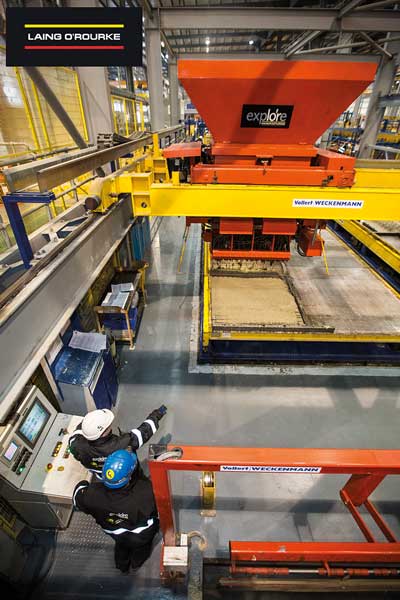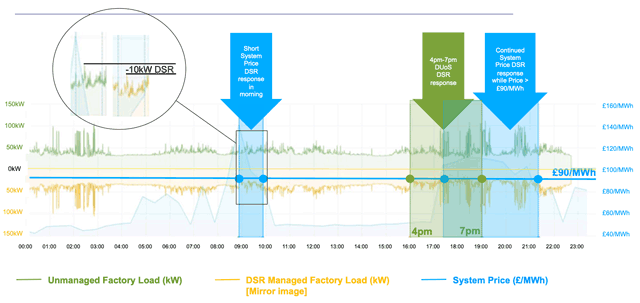A recent European research project demonstrated how techniques used to optimise operation of the electricity distribution grid can also be applied to factories. Dr Graham Ault, executive director of Smarter Grid Solutions, explains.
The energy transition is leading many commercial and industrial customers to re-evaluate their energy and sustainability objectives and programmes. A recently completed European research and demonstration project, “OPTIMISED” under the Horizon 2020 programme, implemented a distributed energy resources management system (DERMS) at Laing O’Rourke’s construction products factory at the Explore Industrial Park at Worksop. The intention was to demonstrate DERMS capabilities and quantify the benefits to commercial and industrial customers.
In the electricity utilities sector, a DERMS integrates grid measurements, energy market information and renewable energy operating status, implements control instructions and schedules business and system operating rules. One application might be to maximise the connection of renewable energy to the distribution grid within technical limits, but without the need for capital investment to upgrade the power lines and substations. Other DERMS applications focus on, for example, optimising the daily charge and discharge schedule for battery energy storage to allow “revenue stacking” by providing services to grid and market participants while managing energy for the battery host site operator.
The OPTIMISED project took DERMS a step further by configuring the data architecture within the factory, integrating external sources of information and establishing controls to tap value streams in the factory and industrial environment.

The Laing O’Rourke demonstration showed how two different grid flexibility or demand side response schemes could make savings to factory energy costs. The first of these was reducing demand at network peak periods, known as Distribution Use of System Red Band Reduction. DUoS is the charge for connection to the grid, which is at a peak during the “red band” period between 4-7pm when overall demand is highest. The second service responded to the system balancing price, which has value to wholesale electricity market participants and can be shared with customers who can change their demand or generation patterns at specific times.
Being able to stack or combine these value streams with others (such as shifting energy consumption to more advantageous times within time-differentiated electricity tariffs, or providing other services to the electricity system operator or the distribution network company) has growing value in the evolving energy system and this is expected to increase with time.
The graph below shows an example of flexibility in operation for a day in October 2018. A one-hour system price demand side response event occurs between 09:00 and 10:00 in the morning, when the system price (shown by the blue line) rises above the £90/MWh threshold. The DUoS red band response is activated in the period 16:00-19:00, during which a second system price response begins at 17:30 and continues to 21:30 in the evening. In each case, demand is reduced by 10kW, the maximum turndown in capacity it had been possible to identify at the site.

Adding new energy assets (such as rooftop solar photovoltaics or battery energy storage) to such a factory site not only provides an on-site source of energy, but also a source of valuable energy management flexibility. The value of the flexibility can be managed and optimised through the use of a DERMS.
The project analysed the financial value of the DUoS Red Band and System Price response services and how these would be increased with the deployment of solar PV and battery energy storage, both energy assets that Laing O’Rourke was considering.
The value of the two demonstrated flexible response services was about £10,000 annually, as well as reducing carbon dioxide emitted by electricity generation by 12,000kg. This could be increased significantly by combining them with other flexibility services, and again with the use of renewable energy and battery technologies.
The project concluded that the implementation of DERMS in factory environments and the configuration of DSR, factory production scheduling and the analysis of DSR/DER investment cases show promising opportunities for advanced energy management.
Specifically, demand side response on the DERMS platform allowed two different UK market services: system price response and DUoS red band (network tariff) response. The DERMS platform can arbitrate between system flexibility services and co-optimise the demand side response with any new clean energy or DER assets.
Data was an overriding enabler and with several industry initiatives to make more sources of energy data available, the opportunity to use this to create value in industrial facilities will grow.
Smarter Grid Solutions (SGS) is a provider of DERMS software, with 70 staff and offices in Glasgow, London, New York and California.
Contact: Dr Graham Ault,
gault@smartergridsolutions.com, +44 (0) 141 568 4336,
www.smartergridsolutions.com
Laing O’Rourke contact: Dr Graham Herries,
GHerries@laingorourke.com, +44 (0) 781 8010585,
www.laingorourke.com

